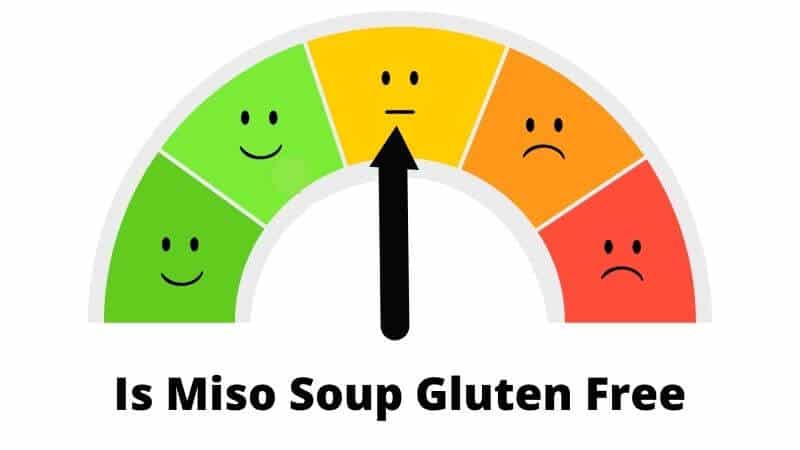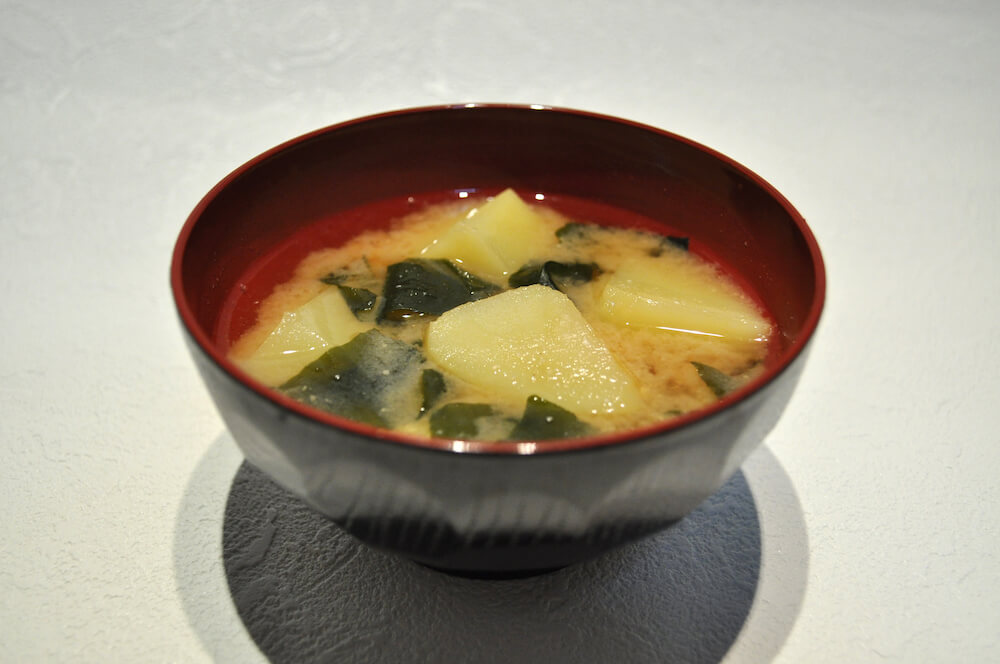Is Miso soup gluten free? This will depend on the type of miso paste you use. If the miso paste if fermented from soybeans, the soup will be gluten free, however if it’s fermented from barley or wheat, it is most definitely NOT gluten free.
In this article, we will try and explain what miso soup is, what are the ingredients and if it’s safe to eat on a gluten free diet.
In this article:
- Miso soup gluten free confidence score
- What is miso soup
- Gluten free miso brands
- Types of soup
- Conclusion
Miso Soup Gluten Free Confidence Score

As you can see from the scale above, Miso soup could be gluten free and also not, it is all dependent on the type of miso paste you use or the restaurant use when you order, make sure to ask and make sure the paste is made from soybeans and not wheat or barely.
What is Miso Soup

Miso soup is one of the culinary delights that Japan has gifted the world. It is no easy job to make a bowl of this soup.
At every step – from the dashi stock to the miso paste – there are layers of hard work and complex flavors. Such flavors come from miso paste and dashi stock.
Miso paste, made of beans and grains, adds a hint of pungency to different miso soups.
The GF paste is made of beans like:
- Azuki
- Chickpeas
- Soy
All of these are gluten free.
Miso paste also contains grains. If gluten-containing grains are used in the soup you’re having, it is not safe for you.
Gluten free grains that go into miso include rice, amaranth, millet, and quinoa.
Other grains that can add gluten content to miso are wheat, barley, and rye. If you’re not well acquainted with Japanese food, it will not be easy for you to detect from the name whether it contains gluten grains or not.
For instance, mugi miso contains barley, while tsubu miso has wheat and barley.
On the other hand, awase misos are mixed varieties that may have gluten grains. But the name doesn’t always reveal its gluten status.
You also shouldn’t fall for the myth that the soup’s color can give you the information.
Tips before eating miso soup
- If you’re going to a friend’s place or want to try the new Japanese joint near your house, you better ask the person cooking whether gluten grains are used in the miso soup variety and find a variety that’s for you.
- It is also a good idea to find out if the eatery serving you miso soup has gluten free arrangements, in general.
- Cross-contamination can be a major issue at many restaurants. Find out if they use shared cooking utensils, storage facilities, crockeries, and cutlery for gluten-containing and non-gluten products.
Like most traditional dishes from around the world, miso soup, too, is now available in the form of mixes so that you can make your own miso soup at home.
If you’re more traditional in your cooking style, you can bring home miso paste, dashi powder, and other ingredients like tofu and wakame.
A good way to ensure that all these products are gluten free is to look at the list of ingredients and make sure that everything used is naturally free from gluten.
Needless to say, the only fool-proof way to get the safest products is by looking for certified gluten free items with a clear label to mark that.
Gluten Free Miso Brands
There are several gluten free miso variants. Some of them are as follows:
| Eden Foods | Their Shiro Miso and Brown Rice Miso are marked on their website as gluten free. |
| South River Miso | They have eight misos with gluten free ingredients but are made with the same tools they use for their barley miso, though the equipment is thoroughly washed first. |
| Edward & Sons | Its four instant miso soup varieties proudly show off the gluten free label. |
| Marukome Miso | This product is marked gluten free on the container and is safe for you. |
| Hikari Miso | The organic miso varieties of this brand are gluten free and safe for you. |
If the product is not certified as gluten free, it means that it hasn’t been tested for gluten content in the ingredients, manufacturing, and storage facilities.
So the final products for trace gluten. Even if it contains naturally gluten free ingredients, you won’t know if there has been cross-contamination.
Certified miso products in the market are quite few in number. As a result, you might have to settle for those with naturally gluten free ingredients.
Types of Miso Soups
There are different types of miso, and they all have different levels of boldness in flavor and color.
It all depends on the ingredients used and the duration of fermentation. Let’s take a look at how miso soups differ from each other on the basis of the ingredients used –
- Kome Miso: Most popular miso in Japan, made with white rice, and available in different colors
- Genmai Miso: Used mostly in North America, made with brown rice, with a nutty taste
- Mugi Miso: Fermented with barley to give it a dark brown color and earthy flavor
- Mame Miso: A mix of soybeans and other grains for a dark color and rich taste
- Soba Miso: An uncommon miso made with buckwheat added during fermentation
These are some common categories of miso on the basis of ingredients. You can also categorize them by color. Let’s take a look:

- Shiro Miso
This is the white miso that is known for its light color and mild and sweet flavor.
It is also used for making marinades and dressings, besides soups. This type of miso paste is light on the soybean content, while the koji, i.e., cultured grains, is a little higher in concentration. The fermentation process is shorter.
- Shinshu Miso
This is the yellow miso variety, made by extending the fermentation process a little more than white miso.
The quantity of soybeans and barley is a little more, too. The flavor is more on the salty and acidic side of the scale, making the paste a multipurpose condiment and flavoring agent for soups.
- Aka Miso
This is the red miso variant with which things start to get more intense in terms of color and flavors.
The fermentation process is the longest, and it contains the highest amount of soybeans. It is sour and salty, with a bold pungency to it. It adds complex flavors to stews and other hearty Japanese dishes.
- Awase Miso
This is actually mixed miso. Simply put, this kind of miso contains a combination of red and white misos and has a unique balance of delicateness and richness of taste.
It is used as a multipurpose flavoring agent in different types of soups and dishes in Japanese cuisine due to its versatility.
These are the broad categories of misos. There are other misos, too. These are used in soups in different quantities, with other delicious ingredients to make a wide variety of miso soups, all varying in color and flavor.
Accordingly, they influence the look and taste of the soups – or other dishes – into which they go.
Conclusion
Miso soup is a culinary delight because of the wide range of flavors that it can bring you.
Miso contains grains, which may or may not include gluten-rich wheat, barley, or rye. You need to find out what’s in your soup before eating it.
If you’re planning to make miso soup at home, you must check the ingredients to ensure they’re gluten free.
Miso paste, the key ingredient in miso soups, may also be made with non-gluten grains, but there’s still a possibility of cross-contamination. So it’s best to pick certified gluten free miso paste and mixes.